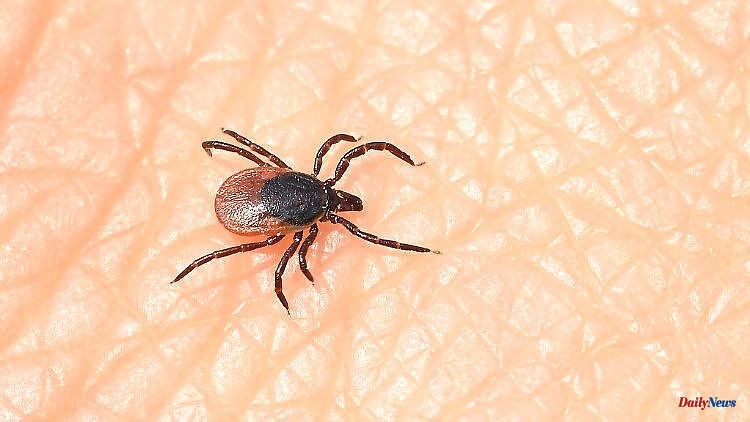Spring is coming, and with it more time in nature for many people. The RKI has now identified new areas in which people should be particularly wary of tick bites.
Berlin (dpa/lby) - In Bavaria, the risk areas for the encephalitis TBE, which is usually transmitted by ticks, have been expanded. The districts of Fürstenfeldbruck and the urban district of Munich have been added, as the Robert Koch Institute (RKI) reports in a recent report. This means that 94 of the 96 Bavarian districts and urban districts are now designated as areas and almost 180 districts nationwide as risk areas.
TBE stands for tick-borne encephalitis. The majority of infections with the virus are symptomless. The risk of serious illness is significantly increased in people over 60 years of age. According to the State Office for Health and Food Safety (LGL), there were a total of 260 TBE cases in Bavaria in 2022. In 2021 there were 187 cases.
The Standing Vaccination Commission (Stiko) recommends a TBE vaccination for people who live, work or stay there for other reasons in TBE risk areas and are therefore at risk of tick bites. According to the RKI, 98 percent of the TBE patients reported in 2022 were not or insufficiently vaccinated. Vaccination rates are also low in risk areas. A high proportion of cases are therefore considered avoidable.
Bavaria's Health Minister Klaus Holetschek called for vaccination again. "The disease can be particularly difficult in older people, but children are also at risk. Currently, only 36.8 percent of schoolchildren in Bavaria are vaccinated against TBE," said the CSU politician.
The classification of risk areas is based on data on reported TBE diseases from 2002 to 2022. According to the RKI, there is a risk of infection above all in Bavaria and Baden-Württemberg, in southern Hesse, in south-eastern Thuringia, in Saxony and since the previous year also in south-eastern Brandenburg. There are also individual risk areas in other federal states. According to the RKI, there are also isolated infections outside of designated risk areas.
According to the RKI report, 546 TBE diseases were reported nationwide in 2022, 30 percent more than in the previous year. A small proportion of those affected were probably infected abroad. The number of cases recorded has fluctuated greatly between 195 (2012) and 717 (2020) since 2001, it said. In 2022, two deaths were recorded in this connection.
Tick bites are usually given as a possible source of infection. Those affected did not always notice the sting. According to the report, transmission is also possible through raw milk, but this is rare.
The RKI writes that the TBE vaccination offers the most reliable protection. Since TBE viruses get into people at the beginning of the act of sucking, they have to be removed immediately and the wound disinfected. Searching the body later and pulling out ticks protect little. "Tick bites can be prevented in part by protective measures such as wearing closed clothing, avoiding undergrowth and tall grass, and staying on fixed paths."
Ticks can also transmit the causative agent of Lyme disease, which often occurs hours after the act of sucking. According to the RKI, it is much more common and occurs throughout Germany. The first symptom is often an increasing redness around the puncture site, later nerves, joints and heart can be affected by the bacteria.












